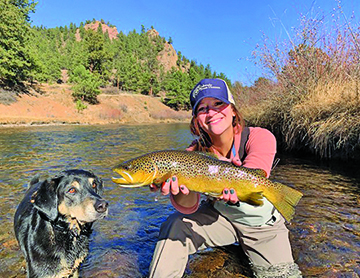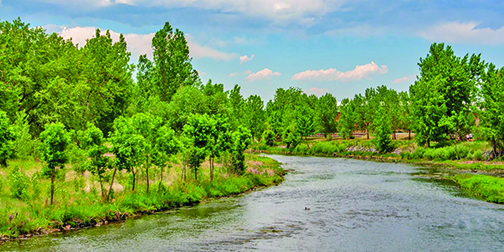Nebraska Plans To Use Eminent Domain To Take Colorado Land, Build A Canal To Divert Denver Destined Water Into Husker State
by Glen Richardson

Deepening Drought: Eight western states are in severe drought conditions and Nebraska isn’t one of them. Map shows levels of drought, much of it severe (dark orange), extreme (red), or exceptional (dark red). Data is from the National Drought Mitigation Center.

Fishing Vs. Feedlots: With more cattle than people, Nebraska seeks more water for its 1.94 million head of cattle. It takes 1,847 gallons of water to produce a pound of beef. The South Platte is also a gold medal western trout river. Photo Courtesy of Danny Frank, Colorado Trout Hunters
Nebraska — with more miles of rivers than any other state — is planning to build a canal into Colorado to drain water from the South Platte River before it can be enjoyed or used by Denver.
Nebraska Governor Pete Ricketts, the state’s attorney general, and the Nebraska legislature have given approval to divert water from the South Platte under a 1923 compact. Nebraska claims Colorado is planning to build projects to serve the Denver area and use the water before it gets to Nebraska.
Nebraska proposes to build more than 60 miles of canals and several reservoirs under a 1923 agreement between the two states. Cornhusker state news sources report, “the project would cost $500 million and be the biggest nonfederal project in decades.” The idea isn’t exactly new, Nebraska attempted to start a canal here before World War I, but ran out of funds and abandoned the project. Denverites can still see relics of the project from Interstate 76 near Julesburg. In the 1980s the state tried to restart the project, but it also failed.
No Set Water Volume

Water Wager: Nebraska is seeking to build a canal into Colorado and drain water from the South Platte River. Shown here as the river flows through Denver at Confluence Park, the plan would destroy outdoor activities in and around the city. Photo Credit: AP Photo/Brennan Linsley
“There is no set volume of water Colorado must allow to flow into Nebraska each year,” according to Kevin Rein, Director of the Colorado Division of Water Resources established in 1881. The Denver native, who is also the state’s engineer, adds, “Currently, the state is meeting all its water obligations to Nebraska.”
From April 1 to Oct. 15 — the irrigation season — the South Platte must flow at 120 cubic feet per second into Nebraska. The flow is measured at a water gate in Julesburg south of the Colorado border, Rein explains. During the non-irrigation season, there is no such requirement for the state and officials believe, “Colorado has uninterrupted water rights for the South Platte.”
Should flows drop below the threshold, the state must curtail water use to certain areas for water right holders whose rights were established after 1897.
Deals With Nine States
Snowmelt from the Rocky Mountains of Colorado is the prime source of water for the West. The state has signed nine compacts with other states over the years to define how much water each can use and the amount they must let flow downstream to neighboring states.
Nearly a century ago when Colorado River water was divvied up, it was a wetter period than normal. As a result, states vastly overestimated the river’s annual flow. Currently the river’s reserves are especially low, yet states are still claiming the same amount of water as they always have.
Presently eight western states are in severe drought conditions — California, Arizona, Nevada, Oregon, Washington, Idaho, and Montana — and Nebraska isn’t one of them. The most recent University of Nebraska Drought Monitor indicates that, “98% of the state is in at least a moderate drought.”
Mega-Drought
For all the warnings people in Denver get about turning off sprinklers and taking shorter showers, agriculture uses by far the most water. Ranching and farming uses more than 70% of the water that flows from the Colorado River to the seven river basin states.

Beauty Of The River: Beautiful and scenic, the South Platte offers splash-worthy adventures. It is amazing to walk along the river and enjoy the relaxing view, free from city distractions.
The West’s current mega-drought is the driest 22-year period since the year 800 C.E. The NOAA Spring Outlook predicts prolonged, persistent drought in the West with below average precipitation.
Intensifying drought and declining reservoir levels have prompted the first-ever cuts to Arizona from the Colorado River. Canals are empty and Arizona crops are weathering. Lake Powell’s massive Colorado River reservoir is at its lowest level on record. A hydroelectric plant on Lake Powell that feeds electricity to millions needs only to fall 35-ft. and it could no longer support power generation.
Cattle Vs. People
A major reason Nebraska requires so much water despite a moderate drought compared to other western states is the number of cattle. There are 1.94 million head of cattle in the state compared to just 1.8 million people.
Nebraska is the nation’s top cow/calf, cattle feeding, and beef processing state. It takes 1,847 gallons of water to produce one pound of beef.
Growing crops to feed animals consumes 56% of the water used, and in 2021 Nebraska planted 9.9 million acres to corn. More than 1.85 billion bushels were harvested last year, up 17% from 2020, making Nebraska the nation’s third largest corn producing state.
About The Platte

Fiddling With Flow: The Platte River begins high in the Rocky Mountains of Colorado, then flows through central Denver at the confluence with Cherry Creek pictured here.
The river begins high in the Rocky Mountains of Colorado, then flows through central Denver at its confluence with Cherry Creek. From Colorado’s Great Plains the river goes into Western Nebraska until it reaches the Missouri River at Plattsmouth, Neb.
In and around Denver it is popular for hiking, biking, and fishing. The South Platte is a gold medal western trout river. The river serves as an important part of the continental bird migration route, providing habitat for sandhill, whooping cranes, and millions of other migrating birds.
At the end of March, the federal government announced it was awarding Denver $350 million to pay for sweeping renovations to the South Platte. It will restore aquatic, wetland, and riparian wildlife habitats along the river. The project is expected to create 7,000 jobs and protect area homes and other structures from flood risk.
Nebraska Proposal Impact
Western states have been fighting over water since the start of the 20th century, and the latest Nebraska proposal suggests those fights will only intensify amid rising populations as climate change reduces snow-rainfall. The most obvious scenario is the two states will end up in court to determine whether Nebraska can use eminent domain to build the canal and whether it can take more water out of the South Platte if it’s built.
A few argue Nebraska is simply using the proposal as leverage to get Colorado to the negotiating table. However, water professionals believe Colorado’s hand is a “royal flush” and the state won’t consider a counteroffer.
Moreover, the 1923 compact allows Colorado to build a 35,000-acre-feet reservoir in the lower section of the South Platte River and make future appropriations in the upper section. Both uses take precedence over Nebraska’s claim.
